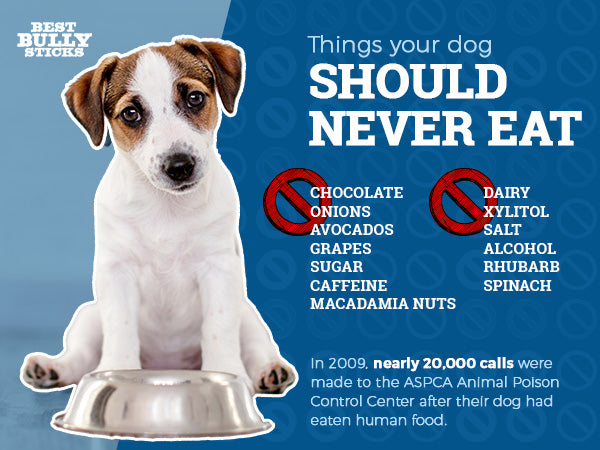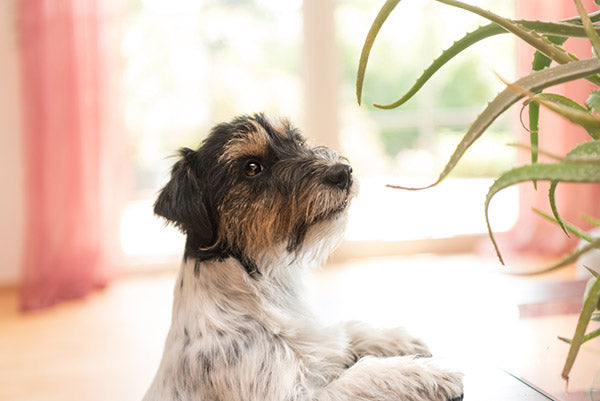

The life of a dog owner isn’t an easy one. In 2009 alone, nearly 20,000 calls were made to the ASPCA Animal Poison Control Center after their dog had eaten human food. But how do you know what’s bad for dogs? What can’t dogs eat?
There’s a long list of things your dog shouldn’t eat, from human foods to lab-made ingredients to common houseplants. Besides keeping these things out of their reach, you can also substitute them with food they can enjoy, from bully sticks to dog chews.
Treat Your Dog to Bully Sticks
So just what can’t your dog eat?


While some cheeses are safe to eat, other cheeses are unsafe for dogs. These are cheeses you should avoid giving to your dog:
Blue cheeses are dangerous because of the mold present. As the cheese ages, it can produce a substance called roquefortine, which is a toxin that could be lethal to your dog.
Moreover, as mentioned above, cheeses with herbs, garlic, and other additives are dangerous because the added flavors themselves could be toxic. Your safest bet is to avoid giving your dog cheese. But if you do, it’s good to know what type of cheese you’re giving to your dog.

The holidays pose a number of safety risks, especially from the amount of baked, sugary goods you’re bound to have scattered around your home and up on your kitchen counter. Likewise, all of the decorations could cause safety issues, as your dog could reach them, get it in their mouth, and potentially choke on it.
The best rule of thumb is if your dog can reach it, they’re going to try and eat it.
Common toxic holiday foods and decorations to keep out of reach include walnuts, sugar-free candy, ornaments, electronics, chestnuts, tinsel, and Christmas lights. Whenever possible, place them where your dog can’t get to them.
You’ll also want to be mindful of what plants you have out. Plants like poinsettias, hollies, lilies, and daffodils are toxic to animals. If you’re using them as decorations, place them somewhere your dog can’t get to them.
It’s important you take precautions, as you don’t want to risk your pet’s health. Moreover, you don’t want to pay the price of being unprepared. The average cost to remove an object from your dog adds up, with surgery costing anywhere between $1,600 to $10,000. Make sure you and your pet can enjoy the holidays, keeping health scares and massive medical bills at bay.

Not all houseplants are safe around your dog. Here are the most common houseplants you shouldn’t have with a dog:
If you’re out buying houseplants and aren’t sure whether they’re safe for your dog to be around or not, just double-check online. It’s important you’re confident it’s safe for your dog prior to bringing it into your home, as a nosy dog could take a bite out of the plant without you ever noticing it.
It’s important you clean up your home prior to bringing your dog home, too. While there are a number of foreign objects that are dangerous to them, posing potential choking hazards, it’s important you clean up to get chemicals, cleaners, and dangerous food away from where they can reach it.
Toxic foods should be kept in the refrigerator or cabinets where your dog cannot reach them. Similarly, cleaning products like bleach, vinegar, and other household cleaners should be kept in closets and cabinets. Choking hazards should also be removed whenever possible, getting them off the floor away from where your dog can get to them.
It’s important you check your yard prior to letting your dog play in it, too. Some wild plants can be dangerous to your dog, so it’s important you weed your yard regularly to protect your dog. Similarly, make sure you don’t leave household and landscaping chemicals out where your dog could get to them, including fertilizers, seeding, deicing salt, bleach, and weed killers.

Soy is a good alternative for dogs with allergies, which often includes foods like beef, dairy, wheat, chicken, and egg. If you’re looking for a cheaper protein free of allergies, the plant-based soy is a great choice.
You’ll often see it listed in stores as the following ingredients:
Too much soy can cause bloating and intestinal pain, so it should be fed in moderation. This way, you can get your dog the necessary protein they need without upsetting their stomach.
While there are some cheeses you should avoid at all costs, there are others that are safe for your dog to eat – in moderation. It’s important to remember that too much dairy can lead to intestinal distress, meaning you might have a smelly mess to clean up after the fact.
Here are cheeses that are safe to feed your dog in moderation:
Be mindful of how much you feed your dog, not only to avoid intestinal issues but to ensure they’re not eating too much fat or calories at once.

The safest thing you can feed your dog, as a snack besides their dog food, are treats. From bully sticks to antlers for dogs, you can give your dog something that’s known to be safe for them. This helps avoid any stress over whether it’s okay for them to eat in the first place.
If you want to mix it up some, you should consider investing in a dog treat subscription box. It’s a simple way to give your dog exciting treats on a regular basis. It’ll get them on their best behavior by knowing they’re going to get something super tasty.
If you think or know your pet ate something they shouldn’t have, you should act accordingly. If you think they may have eaten something, it’s best to keep an eye on them and watch for signs of poisoning or other health problems.
If you know they ate something bad for dogs, it’s time to contact your vet or a poison center. Be sure to keep the following numbers nearby so you can act accordingly:
Protecting your dog can sometimes feel like a full-time job. But if you take proper precaution and puppy proof your house, you can stop your dog from eating something they shouldn’t. Don’t be afraid to rearrange your house to protect your pet.
It’s imperative you do what you can to keep them safe. Keeping harmful objects, food, and items out of the way is the easiest way to protect them. And if they ever feel like getting nosy with what you’re cooking, just slide them some bully sticks or dog chews to keep them entertained and fed.
Comments will be approved before showing up.

Dental chews keep plaque in check and gums strong. Read here to learn about nature's toothbrush!

Single-ingredient dog chews and treats are crafted using only one whole food source!

Check out our guide on different types of chews to help you decide on the best chew for your dog!